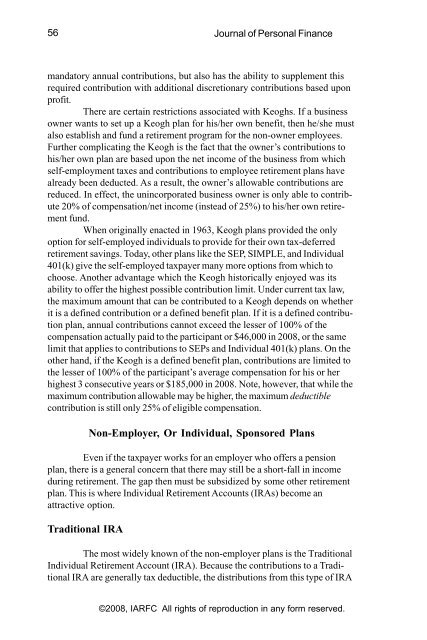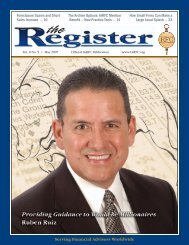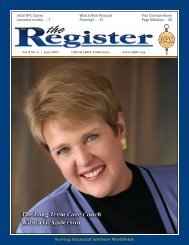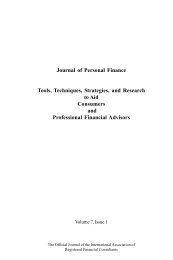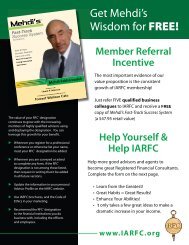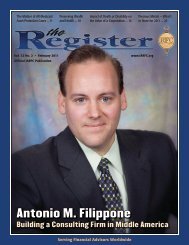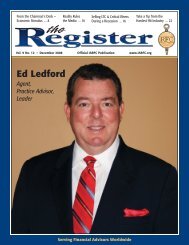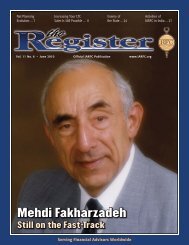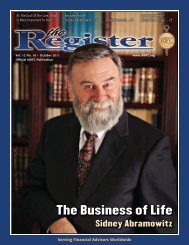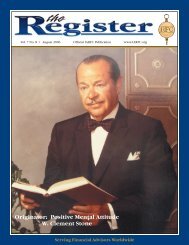3433-vol. 6 issue 2-3.pmd - iarfc
3433-vol. 6 issue 2-3.pmd - iarfc
3433-vol. 6 issue 2-3.pmd - iarfc
Create successful ePaper yourself
Turn your PDF publications into a flip-book with our unique Google optimized e-Paper software.
56<br />
Journal of Personal Finance<br />
mandatory annual contributions, but also has the ability to supplement this<br />
required contribution with additional discretionary contributions based upon<br />
profit.<br />
There are certain restrictions associated with Keoghs. If a business<br />
owner wants to set up a Keogh plan for his/her own benefit, then he/she must<br />
also establish and fund a retirement program for the non-owner employees.<br />
Further complicating the Keogh is the fact that the owner’s contributions to<br />
his/her own plan are based upon the net income of the business from which<br />
self-employment taxes and contributions to employee retirement plans have<br />
already been deducted. As a result, the owner’s allowable contributions are<br />
reduced. In effect, the unincorporated business owner is only able to contribute<br />
20% of compensation/net income (instead of 25%) to his/her own retirement<br />
fund.<br />
When originally enacted in 1963, Keogh plans provided the only<br />
option for self-employed individuals to provide for their own tax-deferred<br />
retirement savings. Today, other plans like the SEP, SIMPLE, and Individual<br />
401(k) give the self-employed taxpayer many more options from which to<br />
choose. Another advantage which the Keogh historically enjoyed was its<br />
ability to offer the highest possible contribution limit. Under current tax law,<br />
the maximum amount that can be contributed to a Keogh depends on whether<br />
it is a defined contribution or a defined benefit plan. If it is a defined contribution<br />
plan, annual contributions cannot exceed the lesser of 100% of the<br />
compensation actually paid to the participant or $46,000 in 2008, or the same<br />
limit that applies to contributions to SEPs and Individual 401(k) plans. On the<br />
other hand, if the Keogh is a defined benefit plan, contributions are limited to<br />
the lesser of 100% of the participant’s average compensation for his or her<br />
highest 3 consecutive years or $185,000 in 2008. Note, however, that while the<br />
maximum contribution allowable may be higher, the maximum deductible<br />
contribution is still only 25% of eligible compensation.<br />
Non-Employer, Or Individual, Sponsored Plans<br />
Even if the taxpayer works for an employer who offers a pension<br />
plan, there is a general concern that there may still be a short-fall in income<br />
during retirement. The gap then must be subsidized by some other retirement<br />
plan. This is where Individual Retirement Accounts (IRAs) become an<br />
attractive option.<br />
Traditional IRA<br />
The most widely known of the non-employer plans is the Traditional<br />
Individual Retirement Account (IRA). Because the contributions to a Traditional<br />
IRA are generally tax deductible, the distributions from this type of IRA<br />
©2008, IARFC All rights of reproduction in any form reserved.


